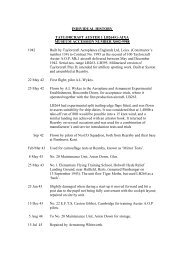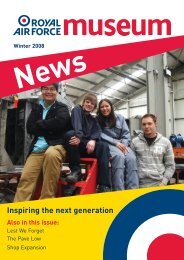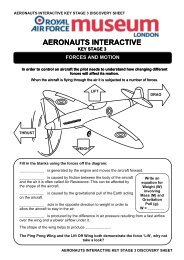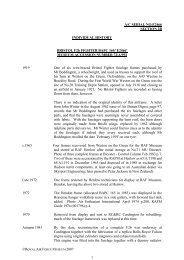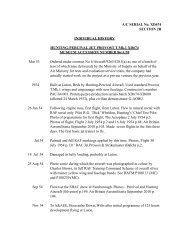Bomber Command Hall - RAF Museum
Bomber Command Hall - RAF Museum
Bomber Command Hall - RAF Museum
Create successful ePaper yourself
Turn your PDF publications into a flip-book with our unique Google optimized e-Paper software.
TEACHERS RESOURCES – WORLD WAR II AIRC<strong>RAF</strong>T<br />
BOMBER HALL<br />
Following the fall of France in 1940, the only way of taking the fight to the enemy was by<br />
undertaking bombing missions against occupied Europe. The bombing offensive against the Axis<br />
powers continued for five years, during which over 55,000 Royal Air Force and 76,000 United States<br />
Air Force, aircrew perished.<br />
This pack will highlight 5 important bomber aircraft from World War II to help you in your self guided tour.<br />
THE AVRO LANCASTER 1<br />
Location: At the entrance to <strong>Bomber</strong> <strong>Hall</strong> from Historic Hangars.<br />
The Lancaster, which first saw action in April 1942, was the <strong>RAF</strong>’s best heavy bomber and for<br />
the last three years of the war was the major heavy bomber used by <strong>Bomber</strong> <strong>Command</strong> to take<br />
the war right into the heart of Nazi Germany.<br />
The Lancaster was fully equipped for night flying and usually flew with a crew of 7 men. This<br />
. included the pilot, flight engineer, radio operator, navigator, and 3 gunners. It was the gunners,<br />
positioned in the rear and mid-upper turrets, who suffered the most as they were forced to sit<br />
through long flights in cold isolation, breathing through oxygen masks and having very little<br />
contact with the rest of the crew, other than through their earphones.<br />
<strong>Bomber</strong> <strong>Command</strong> suffered higher casualty rates than any<br />
other branch of the British services during World War Two.<br />
It is also well worth noting that the average age of the<br />
crew of a Lancaster was only 22.<br />
The yellow bombs painted on the side of this Lancaster<br />
bomber denote the number of missions which it has taken<br />
part in, a total of 137. The average number of missions of a<br />
Lancaster bomber was in fact 21 and only one allied bomber flew<br />
more missions than this.<br />
THE BOEING B-17G FLYING FORTRESS<br />
Location: On the left of the Lancaster bomber, as you look at its nose.<br />
It was the B-17, also known as the Flying Fortress, together with the B-24 Liberator that played,<br />
the most important role in America’s daylight strategic bombing campaign. The B-17 was<br />
loaded with machine guns and could fly at an altitude of up to 9000 metres. When used in mass<br />
formation it could deliver a staggering tonnage of explosives. In clear weather, a sophisticated<br />
Norden Bombsight allowed the B-17 to strike a target that was relatively small.<br />
However, for the 10 man crew of the B-17, conditions were<br />
cramped and uncomfortable as the aircraft was not pressurised,<br />
meaning the effects of air sickness could be horrific.<br />
B-17s were deployed in large fleets, so mass<br />
production was necessary; for every aircraft that was<br />
shot down by the Germans at least another two were<br />
produced in American factories!<br />
One American Officer said “The B-17 was a very sturdy, easy to fly aeroplane that would take<br />
lots of damage and get you home.”<br />
TEACHERS RESOURCES – WORLD WAR II AIRC<strong>RAF</strong>T
TEACHERS RESOURCES – WORLD WAR II AIRC<strong>RAF</strong>T<br />
THE FOCKE WULF FW190A-8/U-1<br />
Location: To the left of the Lancaster bomber, as you look at its nose.<br />
The Focke Wulf was one of the most successful combat aircraft flown during World War II; being<br />
superior to the Spitfire V, the Luftwaffe had the advantage until the first Spitfire IX in July 1942.<br />
The Fw190 proved to be fast, strong and heavily armed with good all round vision and excellent<br />
ground handling. Although it was more advanced than the Messerschmitt Bf109, they operated<br />
side by side as day fighters on all German fronts. As higher performance was demanded of the<br />
Fw190 it was quickly fitted with bomb racks for fighter-bomber work.<br />
As a fighter-bomber it proved itself to be<br />
very adaptable and was used for:<br />
• Hit and run bombing<br />
• Ground attack<br />
• Torpedo attack<br />
• Tactical reconnaissance<br />
THE VICKERS WELLINGTON X<br />
Location: To the right of the Lancaster – adjacent to the Milestones of Flight tunnel.<br />
The two-engine Wellington bomber, introduced into service in 1938, formed the backbone of<br />
<strong>Bomber</strong> <strong>Command</strong> and was Britain’s most effective night bomber until the introduction of fourengine<br />
bombers in 1941.<br />
The Wellington was renowned for the large amount of damage that it could withstand. It was<br />
immensely strong as a result of the geodetic type of construction developed by Barnes Wallis.<br />
Although originally designed as a bomber, the<br />
Wellington also proved effective as a torpedo carrier<br />
and submarine killer in Coastal <strong>Command</strong>, before<br />
moving on to Transport and Training <strong>Command</strong>s.<br />
The Wellington dropped the first 1,880kg ‘Blockbuster’ bomb during the Emden raid of 1941.<br />
THE HANDLEY PAGE HALIFAX II<br />
Location: At the back of the <strong>Bomber</strong> hall behind the Wellington.<br />
The Handley Page Halifax was the second British four-engine bomber to enter service during<br />
World War II and the first to bomb Germany, as part of the Hamburg night bombing raids, on 12-<br />
13 March 1941.<br />
The Halifax was easy to fly, much faster than the Wellington and possessed a good range and<br />
bomb load which meant that it was second only to the Avro Lancaster bomber.<br />
Unfortunately, as it lacked adequate defensive fire power it<br />
suffered heavy losses in <strong>Bomber</strong> <strong>Command</strong> operations over<br />
Germany and was gradually restricted to less hazardous<br />
targets from September 1943. Later in the war, the Halifax<br />
was withdrawn from <strong>Bomber</strong> <strong>Command</strong> and used as mine<br />
layers and torpedo bombers in Coastal <strong>Command</strong>.<br />
Explore<br />
Further<br />
There are 4 other World War II aircraft in the <strong>Bomber</strong> <strong>Hall</strong>: the Heinkel He 162A-2,<br />
the Airspeed Oxford 1, the Avro Anson 1 and the North American TB-25 J Mitchell.<br />
Basic information about these aircraft can be found on our website<br />
www.rafmuseum.org/london<br />
TEACHERS RESOURCES – WORLD WAR II AIRC<strong>RAF</strong>T



